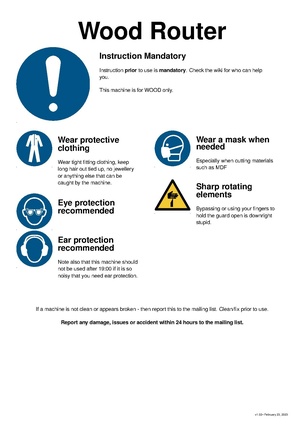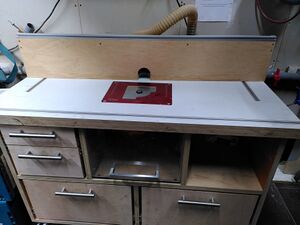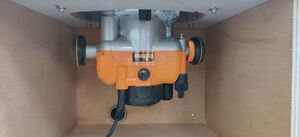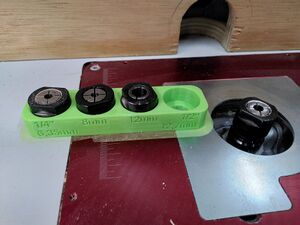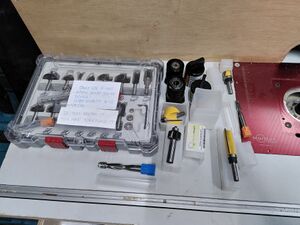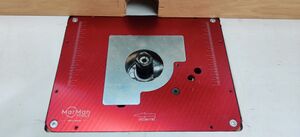Router Table Wood / Tafelfrees hout: verschil tussen versies
| (35 tussenliggende versies door 6 gebruikers niet weergegeven) | |||
| Regel 1: | Regel 1: | ||
| − | [[Category: | + | [[Category:Tools]][[Category:Wood working tools]][[Category:SafetySheet]] |
| + | [[Bestand:Safety-sheet routertable2023.pdf|miniatuur|Safety Sheet router table]] | ||
==General== | ==General== | ||
| − | {{SafetyCat3}}{{NoiseCat2}} | + | {{SafetyCat3}} |
| + | {{NoiseCat2}} | ||
| + | |||
| + | |||
| + | |||
| + | [[Bestand:RouterTable01.jpg|Router table|right|thumb]] | ||
| + | [[Bestand:Router.jpg|Triton TRA001 2400 W router used in the table|right|thumb]]'''PLEASE NOTE''' | ||
| + | |||
| + | |||
| + | '''The current dust collection of the router tabel is sub-optimal (understatement). Meaning the space under the plate will get full of debris. Obviously this harms the operation of the machine. You can use the router table in its current state, provided you clean the space under the plate with the blue vacuum cleaner. Take this seriously and clean very very very very often.''' | ||
| + | |||
| + | |||
| + | |||
| + | |||
| + | |||
The large router table has a high-power inverted router (Triton TRA001, 2400 W) on an insert plate (Marman Tools IP2.0K-TRI). | The large router table has a high-power inverted router (Triton TRA001, 2400 W) on an insert plate (Marman Tools IP2.0K-TRI). | ||
| − | [[Bestand: | + | The router table can now be used. We have a complete set of 5 collets for this router. Including three sizes of metric (6mm, 8mm, and 12mm) and two sizes of imperial (¼" and ½"). Check the size of your router bits! Do not try to use an imperial bit in a metric collet, and visa versa. Make sure you have the correct collet for the bit you are using. The imperial collets are largely only needed if you bought your bits from the US. <br /> |
| + | |||
| + | Keep in mind that this is a new machine and that there is no extensive experience feedback about it yet. | ||
| + | |||
| + | |||
| + | Stay focused and alert when using it. | ||
| + | |||
| + | ==Accessories== | ||
| + | [[Bestand:RouterColletHolder01.jpg|Router collets in 3d printed holder|right|thumb]] | ||
| + | ===Collets=== | ||
| + | We have the full set of 5 collets for this device. They are stored in a green holder in the top left drawer. It is critical that you choose the correct collet for your router bit. This is most important with the 6mm vs ¼" and the 12mm vs ½" collets. If you put the wrong size bit in you risk breaking the collet, or worse, not clamping the bit correctly and producing spinning shrapnel of death. Router bits should have markings on them telling you the shank size, and thus the correct collet to use. Generally leave the 8mm collet fitted to the machine, as that is the most common size used in Europe. The holder has markings for the different sizes, do not trust that the right collet is in the right slot, double check you are using the correct one. Each collet is printed on the top face with the size. | ||
| + | |||
| + | * 6mm collet | ||
| + | * ¼" collet | ||
| + | * 8mm collet | ||
| + | * 12mm collet | ||
| + | * ½" collet | ||
| + | |||
| + | (note the ½" collet is currently not in the holder pending degreasing) | ||
| − | + | NB Make sure to NOT tighten the collet without a bit; the collet can get stuck! | |
| − | + | ===Bits=== | |
| + | [[Bestand:RouterBits-2024-01-26.jpg|thumb|Router bits laying on the router table]] | ||
| − | + | There are a number of router bits available for use with the router table. These are provided as is, with nothing to guarantee they are sharp, they are present, and that they will work. If you want to be absolutely certain that a specific type of bit is available, it's best to buy your own bit. They can be purchased from various places including toolstation, ecotools, fine tools, dictum, and sauter shop. For more info on purchasing, see the [[Leveranciers]] page. The list of available bits, at the time of writing is: | |
| − | |||
| + | * Rebate bit (cuts a 6.35mm rebate into edge of work piece) | ||
| + | * Spiral pattern bit (12mm) | ||
| + | * Spiral bit (6mm) | ||
| + | * bowl bit (19mm) | ||
| + | * 45° chamfer bit with bearing | ||
| + | * long straight pattern bit | ||
| − | + | There is also a box of Bosch router bits which is stored on the shelf above the small wood working machines. This is shared with the hand held routers, make sure they go back where they came from. | |
| − | |||
| − | |||
| − | |||
| − | |||
| − | |||
| − | |||
| − | |||
| − | |||
| − | + | ===Other=== | |
| + | In the top let drawer there is spanner for tightening the collet. As well as a handle for adjusting the cutter height. There are also two steel plates that cover the area around the collet. Make sure you use the correct cover plate. | ||
| − | + | In the second drawer down there are various feather boards. These are to keep your workpiece in place while you cut it. They don't necessarily read far enough to hold thin or small stock. You may find that it helps to use double sided tape to anchor a piece of scrap to thin pieces to provide better registration against the fence. | |
| − | + | ==Setup== | |
| − | + | The current setup was made by Ruud, Thomas and Hedde. Initially the table was made for a hand-made insert (by Alex) with a Bosch router, but the current insert and router were purchased new. The table was designed so that it is mobile (large lockable wheels) and has the same height as the [[:Circular Table Saw / Tafelcirkelzaag|large tablesaw]]. As such it can serve as (additional) support for the sawtable and vice versa the tablesaw can be used as support for large pieces you may want to pass along the inverted router on the router table. | |
| − | |||
| − | |||
| − | |||
| − | |||
| − | |||
| − | |||
| − | |||
| − | |||
| − | |||
| − | |||
| − | + | [[Bestand:Insert plate.jpg|Marman Tools IP2.0K-TRI insert plate|right|thumb]] | |
| − | + | The router is a Triton TRA001 2400 W (see [https://www.tritontools.com/nl-NL/Product/Elektrisch%20gereedschap/Bovenfrezen/TRA001 Manufacturer website]). The insert plate is from Marman Tools IP2.0K-TRI (see [https://marman-tools.com/insert-plate-ip2.0k-tri-predrilled-for-triton-routers manufacturer website]). Please note: | |
| − | The router | + | * The router is VERY powerful, be CAREFUL |
| + | * NEVER WEAR GLOVES when working on the machine | ||
| + | * ALWAYS move the piece in the direction of the arrow (right to left) : climb cutting is prohibited with this machine for obvious safety reasons. | ||
| + | * Be careful when routing endgrain : always try to support the piece close to the router bit (but not with your hand of course, use the pushstick from the table saw for instance) | ||
| + | * Always adjust the amount of material you take off : doing many shallow passes can be tedious but trying to do it in one go and having the piece fly to your face or having a chunk of wood get ripped off your piece is significantly more inconvenient. | ||
| + | * The router speed can and should be adjusted (bigger bits such as chamfer/roundover bits need to spin slower due to their bigger diameter). The speed regulation wheel is located behind the router (not very easy to access) | ||
| + | * There are 2 different size reduction plates for large and small bits. | ||
| + | * Remove the reduction plate (held in place magnetically) to change bits | ||
| + | * There are screws to flush the insert plate AND for the reduction plate | ||
==Mandatory notifications== | ==Mandatory notifications== | ||
| Regel 62: | Regel 92: | ||
# Check if the machine is clean and nothing seems broken | # Check if the machine is clean and nothing seems broken | ||
| + | Wat betreft de machine schoon en veilig achterlaten - per algemene makerspace regel is dit altijd de verantwoordelijkheid van de *laatste* gebruiker. Dus als je de troep van een ander niet wil opruimen; meld het dan - en gebruik de machine niet. Zodra je iets gebruikt ben je verantwoordelijk voor het in goede en schone staat achterlaten van de machine; en het melden van storingen of defecten. | ||
| − | + | As for leaving the machine clean and safe - per general makerspace rule, this is always the responsibility of the *last* user. So if you don't want to clean up someone else's mess; then report it - and do not use the machine. As soon as you use something, you are responsible for leaving the machine in good and clean condition; and reporting malfunctions or defects. | |
==Use== | ==Use== | ||
| − | ... | + | Note: Before bringing the router up to change bits, reach under the table and return the cover that is over the switch on the back left side of the router to the covered position. Else the router jams when it gets to almost vertical. Make sure you do this every time before raising the router. You will want to then move the cover, and toggle the switch when you want to actually use the router. If it doesn't power up when you use the switch on the right of the router table, this is what you have forgotten. |
| + | |||
| + | Note: Do not use the router table and the table saw at the same time, the dust collection system can't cope with it, and you'll end up dumping dust into the air of the room and it takes ages to clear. | ||
| + | |||
| + | # Put on safety glasses at the very least, tie back hair. hearing protection recommended | ||
| + | # Make sure the dust extraction hose is attached to both the back of the cabinet and the fence, and turn on the valve on the grey pipe on the wall. | ||
| + | # Use the crank handle to bring the router all the way up (check the state of the switch cover on the router before raising it, see above for details) | ||
| + | # Insert a bit into the collet and tighten with the spanner (do not overtighten) - Make sure you are using the correct size collet for the bit. | ||
| + | # Make sure you've put a metal cover plate in over the hole where the router collet is. Choose the cover plate that best fits round your router bit. | ||
| + | # Setup the router height with the crank handle (and remove the crank handle when done) | ||
| + | # If using a big bit, adjust the rotation speed by reaching under the router on the other side. If you rotate all the way to the left, the speed is at the minimum, and to the right at the maximum (TBC ?) | ||
| + | # If needed, adjust the fence | ||
| + | # If needed, you can use fingerboards to keep your workpiece tight against the fence + reduce the risk of kickback | ||
| + | # Perform a visual check that nothing is in contact with the bit | ||
| + | # Make sure the front door is closed | ||
| + | # Start the machine with the switch on the right side of the machine | ||
| + | # If the sound does not seem right or if you can feel vibrations, stop the machine immediately | ||
| + | # If you need to route multiple pieces with the same setup, turn off the machine between each pass | ||
==After use== | ==After use== | ||
# Clean the machine well, also the sawdust accumulated around the router | # Clean the machine well, also the sawdust accumulated around the router | ||
| − | # . | + | # Put the crank handle and spanner in the upper left drawer |
| + | # Remove and clean finger boards. Store them in left drawer. | ||
==Instructions== | ==Instructions== | ||
| − | People who can give instructions are: | + | People who can give instructions are listed [https://mijn.makerspaceleiden.nl/acl/machine/40 on the machine page in mijn.makerspaceleiden.nl]. |
| − | |||
| − | |||
| − | |||
Instructions consist of an in-person introduction to the safety aspects of the machine as well as best-practice uses. | Instructions consist of an in-person introduction to the safety aspects of the machine as well as best-practice uses. | ||
| Regel 84: | Regel 130: | ||
Email with accidents to: bestuur@makerspaceleiden.nl | Email with accidents to: bestuur@makerspaceleiden.nl | ||
| + | |||
| + | |||
| + | ==Todo== | ||
| + | Below is a list of further to-do's; for further information contact Ruud or Hedde. | ||
| + | The router table is still under construction, the following steps still need to be taken (14 July 2023 / update 23rd Jan 2024)): | ||
| + | |||
| + | # No tag needed as per June 2023 deelnemers meeting - done | ||
| + | # <s>Finish 2 lower large drawers</s>, make fronts + pull mechanism for all drawers (see 7.) | ||
| + | # Plexiglass door created by Henk - thanks! - done | ||
| + | # Suction hose connected. - done | ||
| + | # <s>I</s>nitial tests have been.NB Make sure to NOT tighten the collet without a bit; the collet can get stuck! | ||
| + | # Test fingerboards and add-ons - done | ||
| + | # Make fronts for drawers and door for cabinet top right<br /> | ||
| + | # Organize everything and update this wiki-page - wip | ||
| + | # <s>Formulate instructions and add to permissions system + give instructions - done</s> | ||
| + | # <s> Move stuff in cabinet back-right, sort, talk to members and Hans D (it's mosltly his stuff) where this should go, re-organize and move new router table in place of cabinet with old router table (is also owned by Hans D) on top </s> | ||
| + | |||
| + | Do YOU want to help with any or all of the above? PLEASE! Contact Hedde or Ruud. Or just mail to all deelnemers. | ||
Huidige versie van 16 nov 2024 om 23:56
Inhoud
General
This equipment is safety category 3:
- Mandatory, in person, instructions.
- Make sure you read the Wiki before asking.
This equipment is Noise Category 2:
Can be used at all hours, but in moderation.
Be considerate; if you feel you need to wear ear protection,
then only use the tool between 07:00 and 19:00.
PLEASE NOTE
The current dust collection of the router tabel is sub-optimal (understatement). Meaning the space under the plate will get full of debris. Obviously this harms the operation of the machine. You can use the router table in its current state, provided you clean the space under the plate with the blue vacuum cleaner. Take this seriously and clean very very very very often.
The large router table has a high-power inverted router (Triton TRA001, 2400 W) on an insert plate (Marman Tools IP2.0K-TRI).
The router table can now be used. We have a complete set of 5 collets for this router. Including three sizes of metric (6mm, 8mm, and 12mm) and two sizes of imperial (¼" and ½"). Check the size of your router bits! Do not try to use an imperial bit in a metric collet, and visa versa. Make sure you have the correct collet for the bit you are using. The imperial collets are largely only needed if you bought your bits from the US.
Keep in mind that this is a new machine and that there is no extensive experience feedback about it yet.
Stay focused and alert when using it.
Accessories
Collets
We have the full set of 5 collets for this device. They are stored in a green holder in the top left drawer. It is critical that you choose the correct collet for your router bit. This is most important with the 6mm vs ¼" and the 12mm vs ½" collets. If you put the wrong size bit in you risk breaking the collet, or worse, not clamping the bit correctly and producing spinning shrapnel of death. Router bits should have markings on them telling you the shank size, and thus the correct collet to use. Generally leave the 8mm collet fitted to the machine, as that is the most common size used in Europe. The holder has markings for the different sizes, do not trust that the right collet is in the right slot, double check you are using the correct one. Each collet is printed on the top face with the size.
- 6mm collet
- ¼" collet
- 8mm collet
- 12mm collet
- ½" collet
(note the ½" collet is currently not in the holder pending degreasing)
NB Make sure to NOT tighten the collet without a bit; the collet can get stuck!
Bits
There are a number of router bits available for use with the router table. These are provided as is, with nothing to guarantee they are sharp, they are present, and that they will work. If you want to be absolutely certain that a specific type of bit is available, it's best to buy your own bit. They can be purchased from various places including toolstation, ecotools, fine tools, dictum, and sauter shop. For more info on purchasing, see the Leveranciers page. The list of available bits, at the time of writing is:
- Rebate bit (cuts a 6.35mm rebate into edge of work piece)
- Spiral pattern bit (12mm)
- Spiral bit (6mm)
- bowl bit (19mm)
- 45° chamfer bit with bearing
- long straight pattern bit
There is also a box of Bosch router bits which is stored on the shelf above the small wood working machines. This is shared with the hand held routers, make sure they go back where they came from.
Other
In the top let drawer there is spanner for tightening the collet. As well as a handle for adjusting the cutter height. There are also two steel plates that cover the area around the collet. Make sure you use the correct cover plate.
In the second drawer down there are various feather boards. These are to keep your workpiece in place while you cut it. They don't necessarily read far enough to hold thin or small stock. You may find that it helps to use double sided tape to anchor a piece of scrap to thin pieces to provide better registration against the fence.
Setup
The current setup was made by Ruud, Thomas and Hedde. Initially the table was made for a hand-made insert (by Alex) with a Bosch router, but the current insert and router were purchased new. The table was designed so that it is mobile (large lockable wheels) and has the same height as the large tablesaw. As such it can serve as (additional) support for the sawtable and vice versa the tablesaw can be used as support for large pieces you may want to pass along the inverted router on the router table.
The router is a Triton TRA001 2400 W (see Manufacturer website). The insert plate is from Marman Tools IP2.0K-TRI (see manufacturer website). Please note:
- The router is VERY powerful, be CAREFUL
- NEVER WEAR GLOVES when working on the machine
- ALWAYS move the piece in the direction of the arrow (right to left) : climb cutting is prohibited with this machine for obvious safety reasons.
- Be careful when routing endgrain : always try to support the piece close to the router bit (but not with your hand of course, use the pushstick from the table saw for instance)
- Always adjust the amount of material you take off : doing many shallow passes can be tedious but trying to do it in one go and having the piece fly to your face or having a chunk of wood get ripped off your piece is significantly more inconvenient.
- The router speed can and should be adjusted (bigger bits such as chamfer/roundover bits need to spin slower due to their bigger diameter). The speed regulation wheel is located behind the router (not very easy to access)
- There are 2 different size reduction plates for large and small bits.
- Remove the reduction plate (held in place magnetically) to change bits
- There are screws to flush the insert plate AND for the reduction plate
Mandatory notifications
- Whoever uses this *must* notify other members if there are disruptions or defects
- Accidents and near-accidents must be be notified to other members (anything more than a small bandaid)
Before use
- You can only use the router table after you've had instructions (see below + in person needed)
- Check if the machine is clean and nothing seems broken
Wat betreft de machine schoon en veilig achterlaten - per algemene makerspace regel is dit altijd de verantwoordelijkheid van de *laatste* gebruiker. Dus als je de troep van een ander niet wil opruimen; meld het dan - en gebruik de machine niet. Zodra je iets gebruikt ben je verantwoordelijk voor het in goede en schone staat achterlaten van de machine; en het melden van storingen of defecten.
As for leaving the machine clean and safe - per general makerspace rule, this is always the responsibility of the *last* user. So if you don't want to clean up someone else's mess; then report it - and do not use the machine. As soon as you use something, you are responsible for leaving the machine in good and clean condition; and reporting malfunctions or defects.
Use
Note: Before bringing the router up to change bits, reach under the table and return the cover that is over the switch on the back left side of the router to the covered position. Else the router jams when it gets to almost vertical. Make sure you do this every time before raising the router. You will want to then move the cover, and toggle the switch when you want to actually use the router. If it doesn't power up when you use the switch on the right of the router table, this is what you have forgotten.
Note: Do not use the router table and the table saw at the same time, the dust collection system can't cope with it, and you'll end up dumping dust into the air of the room and it takes ages to clear.
- Put on safety glasses at the very least, tie back hair. hearing protection recommended
- Make sure the dust extraction hose is attached to both the back of the cabinet and the fence, and turn on the valve on the grey pipe on the wall.
- Use the crank handle to bring the router all the way up (check the state of the switch cover on the router before raising it, see above for details)
- Insert a bit into the collet and tighten with the spanner (do not overtighten) - Make sure you are using the correct size collet for the bit.
- Make sure you've put a metal cover plate in over the hole where the router collet is. Choose the cover plate that best fits round your router bit.
- Setup the router height with the crank handle (and remove the crank handle when done)
- If using a big bit, adjust the rotation speed by reaching under the router on the other side. If you rotate all the way to the left, the speed is at the minimum, and to the right at the maximum (TBC ?)
- If needed, adjust the fence
- If needed, you can use fingerboards to keep your workpiece tight against the fence + reduce the risk of kickback
- Perform a visual check that nothing is in contact with the bit
- Make sure the front door is closed
- Start the machine with the switch on the right side of the machine
- If the sound does not seem right or if you can feel vibrations, stop the machine immediately
- If you need to route multiple pieces with the same setup, turn off the machine between each pass
After use
- Clean the machine well, also the sawdust accumulated around the router
- Put the crank handle and spanner in the upper left drawer
- Remove and clean finger boards. Store them in left drawer.
Instructions
People who can give instructions are listed on the machine page in mijn.makerspaceleiden.nl.
Instructions consist of an in-person introduction to the safety aspects of the machine as well as best-practice uses.
Email with problems and defects to: deelnemers@makerspaceleiden.nl
Email with accidents to: bestuur@makerspaceleiden.nl
Todo
Below is a list of further to-do's; for further information contact Ruud or Hedde. The router table is still under construction, the following steps still need to be taken (14 July 2023 / update 23rd Jan 2024)):
- No tag needed as per June 2023 deelnemers meeting - done
Finish 2 lower large drawers, make fronts + pull mechanism for all drawers (see 7.)- Plexiglass door created by Henk - thanks! - done
- Suction hose connected. - done
Initial tests have been.NB Make sure to NOT tighten the collet without a bit; the collet can get stuck!- Test fingerboards and add-ons - done
- Make fronts for drawers and door for cabinet top right
- Organize everything and update this wiki-page - wip
Formulate instructions and add to permissions system + give instructions - doneMove stuff in cabinet back-right, sort, talk to members and Hans D (it's mosltly his stuff) where this should go, re-organize and move new router table in place of cabinet with old router table (is also owned by Hans D) on top
Do YOU want to help with any or all of the above? PLEASE! Contact Hedde or Ruud. Or just mail to all deelnemers.
